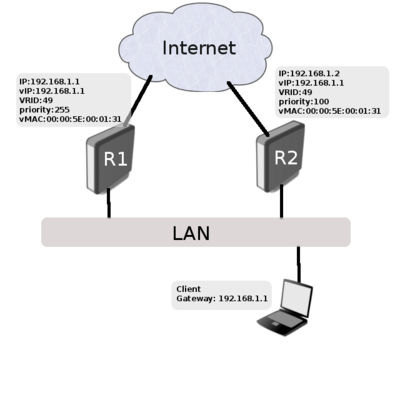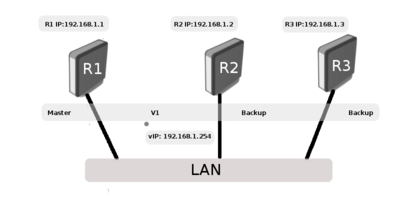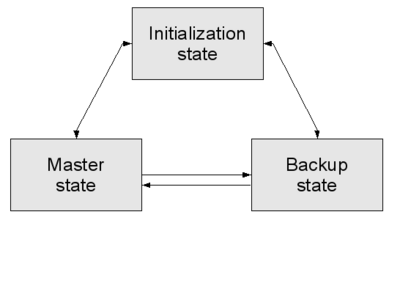Manual:Interface/VRRP
Summary
Sub-menu level: /interface vrrp
Standards: RFC 5798, RFC 3768
This chapter describes the Virtual Router Redundancy Protocol (VRRP) support in RouterOS.
Mostly on larger LANs dynamic routing protocols ((OSPF or RIP)) are used, however there are number of factors that may make undesirable to use dynamic routing protocols. One alternative is to use static routing, but if statically configured first hop fails, then host will not be able to communicate with other hosts.
Virtual Router Redundancy Protocol (VRRP) provides a solution by combining number of routers into logical group called Virtual Router (VR). VRRP implementation in RouterOS is compliant to RFC2338 and any modern routers support this protocol.
Virtual Router Redundancy Protocol

The purpose of the VRRP is to communicate to all VRRP routers associated with the Virtual Router ID and support router redundancy through a prioritized election process among them.
Each VRs node have configured virtual IP address and virtual MAC address. On one of nodes virtual IP is the same as real IP, this node is called Owner. By default owner has the highest priority (255), other routers have lower priorities and are configured to operate as Backup in case the Owner router is unreachable.
Normally Owner operates as a Master router of VR. When Owner becomes unavailable, election process occur and Backup router becomes current Master.
All VRRP routers belonging to the same VR must be configured with the same advertisement interval. If interval does not match router will discard received advertisement packet.
VRRP packets are encapsulated in IP packets and are sent to the IPv4 multicast address. IP multicast address assigned by the IANA for VRRP is 224.0.0.18 and VRRP protocol number is /112 Router will drop any VRRP packet if TTL is not 255. That protects against VRRP packets being injected from another remote network. This limits most vulnerabilities to local attacks.
Virtual Router (VR)
A Virtual Router (VR) consists of one Owner router and one or more backup routers belonging to the same network.
VR includes:
- VRID configured on each VRRP router
- the same virtual IP on each router
- Owner and Backup configured on each router. On a given VR there can be only one Owner.
Virtual MAC address
VRRP automatically assigns MAC address to VRRP interface based on standard MAC prefix for VRRP packets and VRID number. First five octets are 00:00:5E:00:01 and last octet is configured VRID. For example, Virtual Routers VRID is 49, then virtual MAC address will be 00:00:5E:00:01:31.
Virtual IP address
Virtual IP associated with VR must be identical and set on all VR nodes. On Owner router Virtual IP must be the same as real IP. For example on Owner router real IP and virtual IP is 192.168.1.1, on Backup router virtual IP is 192.168.1.1, but real IP is 192.168.1.2. All virtual and real addresses should be from the same network.

Note: It is not recommended to set up Mikrotik router as an Owner router. VRRP address and real IP address should not be the same.
Multiple Virtual IPs
If the Master of VR is associated with multiple IP addresses, then Backup routers belonging to the same VR must also be associated with the same set of virtual IP addresses. If virtual address on the Master is not also on Backup a misconfiguration exists and VRRP advertisement packets will be discarded.
ARP
The Master for a given VR responds to ARP requests with the VR's assigned MAC address. Virtual MAC address is also used as the source MAC address for advertisement packets sent by Master. To ARP requests for non-virtual IP addresses router responds with the system MAC address. Backup routers are not responding to ARP requests for Virtual IPs.
Owner

An Owner router for a VR is default Master router and operates as the Owner for all subnets included in the VR. As mentioned before priority on an owner router must be the highest value (255). In example network R1 is an Owner. It's priority is set to 255 and virtual IP is the same as real IP (owns the virtual IP address).
All Virtual Router members can be configured so that virtual IP is not the same as physical IP. Such Virtual address can be called floating or pure virtual IP address.
Advantage of this setup is flexibility given to the administrator. Since the virtual IP address is not the real address of any one of the participant routers, the administrator can change these physical routers or their addresses without any need to reconfigure the virtual router itself.

Note: RouterOS can not be configured as Owner. Pure virtual IP configuration is the only valid configuration unless non-RouterOS device is set as owner.
Master
Master router in a VR operates as the physical gateway for the network for which it is configured. Selection of the Master is controlled by priority value. Master state describes behavior of Master router. In example network R1 is the Master router. When R1 is no longer available R2 becomes master.
Backup
VR must contain at least one Backup router. Backup router must be configured with the same virtual IP as Master for that VR. Default priority for Backup routers is 100. When current master router is no longer available, backup router with highest priority will become current master. Every time when router with higher priority becomes available it is switched to master. Sometimes this behavior is not necessary. To override it preemption mode should be disabled.
VRRP state machine

As you can see from diagram, each VRRP node can be in one of three states:
- Init state
- Backup state
- Master state
Init state
The purpose of this state is to wait for a Startup event. When this event is received, then following actions are taken:
- if priority is 255, then send advertisement packet, broadcast ARP requests and transit to MASTER state;
- else transit to BACKUP state.
Backup state
When in backup state, node is not responding to ARP requests and is not forwarding traffic for the IP associated with the VR.
Routers main task is to receive advertisement packets and check if master node is available.
Backup router will send out advertisement packets, broadcast ARP requests and transit itself to master state in two cases:
- If priority in advertisement packet is 0;
- When Preemption_Mode is set to no, or Priority in the ADVERTISEMENT is greater than or equal to the local Priority
In other cases advertisement packets will be discarded. When shutdown event is received, transit to Init state.
Master state
When MASTER state is set, VRRP node is responding to ARP requests and forwarding traffic for the IP addresses associated with the VR.
Master router is sending advertisement packets within interval defined in VRRP configuration.
If advertisement packet is received by master node:
- If priority is 0, send advertisement immediately;
- If priority in advertisement packet is greater than nodes priority then transit to backup state
- If priority in advertisement packet is equal to nodes priority and primary IP Address of the sender is greater than the local primary IP Address, then transit to backup state
- Ignore advertisement in other cases
When shutdown event is received, send advertisement packet with priority=0 and transit to Init state.
Configuring VRRP
Setting up Virtual Router is quite easy, only two actions are required - create vrrp interface and set Virtual Routers IP address.
For example, add vrrp to ether1 and set VRs address to 192.168.1.1
/interface vrrp add interface=ether1 /ip address add address=192.168.1.1/32 interface=vrrp1
Notice that only 'interface' parameter was specified when adding vrrp. It is the only parameter required to be set manually, other parameters if not specified will be set to their defaults: vrid=1, priority=100 and authentication=none.
Note that address on VRRP interface must have /32 netmask.
Before VRRP can operate correctly correct IP address is required on ether1. In this example it is 192.168.1.2/24
VRRP Examples section contains several configuration examples.
Property reference
Sub-menu: /interface vrrp
| Property | Description |
|---|---|
| arp (disabled | enabled | proxy-arp | reply-only; Default: enabled) | ARP resolution protocol mode |
| authentication (ah | none | simple; Default: none) | Authentication method to use for VRRP advertisement packets.
|
| interface (string; Default: ) | Interface name on which VRRP instance will be running |
| interval (time [10ms..4m15s]; Default: 1s) | VRRP update interval in seconds. Defines how often master sends advertisement packets. |
| mtu (integer; Default: 1500) | Layer3 MTU size |
| name (string; Default: ) | VRRP interface name |
| on-backup (string; Default: ) | Script to execute when the node is switched to backup state |
| on-master (string; Default: ) | Script to execute when the node is switched to master state |
| password (string; Default: ) | Password required for authentication. Can be ignored if authentication is not used. |
| preemption-mode (yes | no; Default: yes) | Whether master node always has the priority. When set to 'no' backup node will not be elected to be a master until the current master fails, even if the backup node has higher priority than the current master. This setting is ignored if Owner router becomes available |
| priority (integer: 1..254; Default: 100) | Priority of VRRP node used in Master election algorithm. Higher number means higher priority. '255' is reserved to Router that owns VR IP and '0' is reserved for Master router to indicate that it is releasing responsibility. |
| v3-protocol (ipv4 | ipv6; Default: ipv4) | Protocol that will be used by VRRPv3. Valid only if version is 3 |
| version (integer [2, 3]; Default: 3) | Which VRRP version to use. |
| vrid (integer: 1..255; Default: 1) | Virtual Router identifier. Each Virtual router must have unique id number |
There are two ways to add scripts to on-backup and on-master
- specify scripts name added to script repository
- write script directly by putting it in scopes '{ }'.
See more
[ Top | Back to Content ]
